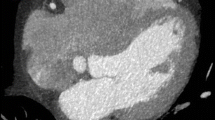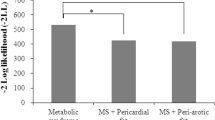Abstract
Purpose of Review
Visceral adipose tissues differentiate from subcutaneous fat by its local and systemic effects. As visceral adipose tissue within the thorax, the epicardial adipose tissue (EAT) surrounds the heart and the coronary arteries.
Recent Findings
Several studies described the association of EAT and cardiovascular risk factors as well as prevalence and incidence of coronary artery disease. General measures of obesity like body mass index can easily be assessed. In contrast, visceral adipose tissue requires imaging modalities like computed tomography or ultrasonography for assessment. While computed tomography is considered the gold standard for measurement of 3D volume of adipose tissues, it acquires high demands in resources and radiation exposure is indispensable. Echocardiography might be an easy accessible alternative without any radiation exposure.
Summary
Epicardial adipose tissue is not routinely measured in clinical routine and further studies are needed to establish measurement of epicardial adipose tissue to alter risk stratification and therefore improve patient’s management. This review article provides an overview over the existing literature describing EAT as an independent cardiovascular risk factor. Furthermore, we describe different imaging modalities which are frequently used in recent studies for EAT assessment.

Similar content being viewed by others
References
Papers of particular interest, published recently, have been highlighted as: • Of importance •• Of major importance
Britton KA, Fox CS. Ectopic fat depots and cardiovascular disease. Circulation. 2011;124(24):837–41. https://doi.org/10.1161/CIRCULATIONAHA.111.077602.
Mahabadi AA, Massaro JM, Rosito GA, Levy D, Murabito JM, Wolf PA, et al. Association of pericardial fat, intrathoracic fat, and visceral abdominal fat with cardiovascular disease burden: the Framingham Heart Study. Eur Heart J. 2009;30(7):850–6.
Schlett CL, Massaro JM, Lehman SJ, Bamberg F, O'Donnell CJ, Fox CS, et al. Novel measurements of periaortic adipose tissue in comparison to anthropometric measures of obesity, and abdominal adipose tissue. Int J Obes. 2009;33(2):226–32.
Rabkin SW. Epicardial fat: properties, function and relationship to obesity. Obes Rev. 2007;8(3):253–61.
Gaborit B, Sengenes C, Ancel P, Jacquier A, Dutour A. Role of Epicardial adipose tissue in health and disease: a matter of fat? Compr Physiol. 2017;7(3):1051–82. https://doi.org/10.1002/cphy.c160034.
Ahn SG, Lim HS, Joe DY, Kang SJ, Choi BJ, Choi SY, et al. Relationship of epicardial adipose tissue by echocardiography to coronary artery disease. Heart. 2008;94(3):e7.
Verma B, Katyal D, Patel A, Singh VR, Kumar S. Relation of systolic and diastolic epicardial adipose tissue thickness with presence and severity of coronary artery disease (The EAT CAD study). J Family Med Prim Care. 2019;8(4):1470–5. https://doi.org/10.4103/jfmpc.jfmpc_194_19.
Sinha SK, Thakur R, Jha MJ, Goel A, Kumar V, Kumar A, et al. Epicardial adipose tissue thickness and its association with the presence and severity of coronary artery disease in clinical setting: a cross-sectional observational study. J Clin Med Res. 2016;8(5):410–9. https://doi.org/10.14740/jocmr2468w.
Tamarappoo B, Dey D, Shmilovich H, Nakazato R, Gransar H, Cheng VY, et al. Increased pericardial fat volume measured from noncontrast CT predicts myocardial ischemia by SPECT. JACC Cardiovasc Imaging. 2010;3(11):1104–12. https://doi.org/10.1016/j.jcmg.2010.07.014.
• Mahabadi AA, Lehmann N, Kälsch H, Robens T, Bauer M, Dykun I, et al. Association of epicardial adipose tissue with progression of coronary artery calcification is more pronounced in the early phase of atherosclerosis: results from the Heinz Nixdorf recall study. JACC Cardiovasc Imaging. 2014;7(9):909–16. An association of EAT and coronary artery calcification in the general population could be described which leads to the suggestion that EAT might be a predictor of early coronary artery disease manifestation.
van Woerden G, Gorter TM, Westenbrink BD, Willems TP, van Veldhuisen DJ, Rienstra M. Epicardial fat in heart failure patients with mid-range and preserved ejection fraction. Eur J Heart Fail. 2018;20(11):1559–66. https://doi.org/10.1002/ejhf.1283 Epub 2018 Aug 1.
Mahabadi AA, Kahlert HA, Dykun I, Balcer B, Kahlert P, Rassaf T Epicardial adipose tissue thickness independently predicts severe aortic valve stenosis. J Heart Valve Dis 2017:26(3):262–267.
Ng ACT, Strudwick M, van der Geest RJ, Ng ACC, Gillinder L, Goo SY, et al. Impact of epicardial adipose tissue, left ventricular myocardial fat content, and interstitial fibrosis on myocardial contractile function. Circ Cardiovasc Imaging. 2018;11(8):e007372. https://doi.org/10.1161/CIRCIMAGING.117.007372.
Dykun I, Mincu R, Hendricks S, Balcer B, Totzeck M, Rassaf T, et al. Efficacy of lipid-lowering therapy beyond statins to prevent cardiovascular events: a meta-analysis. Eur J Prev Cardiol. 2019;2047487319866992. https://doi.org/10.1177/2047487319866992.
• Parisi V, Petraglia L, D'Esposito V, Cabaro S, Rengo G, Caruso A, et al. Statin therapy modulates thickness and inflammatory profile of human epicardial adipose tissue. Int J Cardiol. 2019;274:326–30. https://doi.org/10.1016/j.ijcard.2018.06.106This study emphasizes EAT as a potential new target on statin therapy on accumulation and inflammation.
Alexopoulos N, Melek BH, Arepalli CD, Hartlage GR, Chen Z, Kim S, et al. Effect of intensive versus moderate lipid-lowering therapy on epicardial adipose tissue in hyperlipidemic post-menopausal women: a substudy of the BELLES trial (Beyond Endorsed Lipid Lowering with EBT Scanning). J Am Coll Cardiol. 2013;61(19):1956–61. https://doi.org/10.1016/j.jacc.2012.12.051.
Aldiss P, Davies G, Woods R, Budge H, Sacks HS, Symonds ME. ‘Browning’ the cardiac and peri-vascular adipose tissues to modulate cardiovascular risk. Int J Cardiol. 2017;228:265–74. https://doi.org/10.1016/j.ijcard.2016.11.074.
González N, Moreno-Villegas Z, González-Bris A, Egido J, Lorenzo Ó. Regulation of visceral and epicardial adipose tissue for preventing cardiovascular injuries associated to obesity and diabetes. Cardiovasc Diabetol. 2017;16(1):44. https://doi.org/10.1186/s12933-017-0528-4.
Stolarczyk E. Adipose tissue inflammation in obesity: a metabolic or immune response? Curr Opin Pharmacol. 2017;37:35–40. https://doi.org/10.1016/j.coph.2017.08.006.
Holvoet P. Relations between metabolic syndrome, oxidative stress and inflammation and cardiovascular disease. Verh K Acad Geneeskd Belg. 2008;70(3):193–219.
Sánchez-Torres RJ, Delgado-Osorio H. The metabolic syndrome and its cardiovascular manifestations. Bol Asoc Med P R. 2005;97(4):271–80.
Saklayen MG. The global epidemic of the metabolic syndrome. Curr Hypertens Rep. 2018;20(2):12. https://doi.org/10.1007/s11906-018-0812-z.
Pou KM, Massaro JM, Hoffmann U, Vasan RS, Maurovich-Horvat P, Larson MG, et al. Visceral and subcutaneous adipose tissue volumes are cross-sectionally related to markers of inflammation and oxidative stress: the Framingham Heart Study. Circulation. 2007;116(11):1234–41.
Park JS, Ahn SG, Hwang JW, Lim HS, Choi BJ, Choi SY, et al. Impact of body mass index on the relationship of epicardial adipose tissue to metabolic syndrome and coronary artery disease in an Asian population. Cardiovasc Diabetol. 2010;9:29. https://doi.org/10.1186/1475-2840-9-29.
Demir E, Harmankaya NÖ, Kıraç Utku İ, Açıksarı G, Uygun T, Özkan H et al. The relationship between epicardial adipose tissue thickness and serum interleukin-17a level in patients with isolated metabolic syndrome. Biomolecules 2019:9(3). pii: E97. doi: https://doi.org/10.3390/biom9030097.
• Iacobellis G, Barbaro G. The double role of epicardial adipose tissue as pro- and anti-inflammatory organ. Horm Metab Res. 2008;40(7):442–5. https://doi.org/10.1055/s-2008-1062724This study highlights that EAT is a pro- and anti-inflammatory organ with local as well as systemic effects.
Iacobellis G. Local and systemic effects of the multifaceted epicardial adipose tissue depot. Nat Rev Endocrinol. 2015;11(6):363–71. https://doi.org/10.1038/nrendo.2015.58.
Mazurek T, Zhang L, Zalewski A, Mannion JD, Diehl JT, Arafat H, et al. Human epicardial adipose tissue is a source of inflammatory mediators. Circulation. 2003;108(20):2460–6.
Fain JN, Sacks HS, Bahouth SW, Tichansky DS, Madan AK, Cheema PS. Human epicardial adipokine messenger RNAs: comparisons of their expression in substernal, subcutaneous, and omental fat. Metabolism. 2010;59(9):1379–86. https://doi.org/10.1016/j.metabol.2009.12.027.
Jain SH, Massaro JM, Hoffmann U, Rosito GA, Vasan RS, Raji A, et al. Cross-sectional associations between abdominal and thoracic adipose tissue compartments and adiponectin and resistin in the Framingham Heart Study. Diabetes Care. 2009;32(5):903–8. https://doi.org/10.2337/dc08-1733.
Packer M. Epicardial adipose tissue may mediate deleterious effects of obesity and inflammation on the myocardium. J Am Coll Cardiol. 2018;71(20):2360–72. https://doi.org/10.1016/j.jacc.2018.03.509.
Packer M. Do drugs that ameliorate epicardial adipose tissue inflammation have concordant benefits on atrial fibrillation and on heart failure with a preserved ejection fraction? J Card Fail 2019:pii: S1071–9164(19)30529–30529. doi: https://doi.org/10.1016/j.cardfail.2019.09.002.
Mahabadi AA, Lehmann N, Möhlenkamp S, Pundt N, Dykun I, Roggenbuck U, et al. Noncoronary measures enhance the predictive value of cardiac CT above traditional risk factors and CAC score in the general population. JACC Cardiovasc Imaging. 2016;9(10):1177–85. https://doi.org/10.1016/j.jcmg.2015.12.024.
• Balcer B, Dykun I, Schlosser T, Forsting M, Rassaf T, Mahabadi AA. Pericoronary fat volume but not attenuation differentiates culprit lesions in patients with myocardial infarction. Atherosclerosis. 2018;276:182–8. This study emphasizes the value of the assessment of EAT attenuation via CT.
Iacobellis G, Mahabadi AA. Is epicardial fat attenuation a novel marker of coronary inflammation? Atherosclerosis. 2019;284:212–3. https://doi.org/10.1016/j.atherosclerosis.2019.02.023.
Franssens BT, Nathoe HM, Visseren FL, van der Graaf Y, Leiner T, SMART Study Group. Relation of epicardial adipose tissue radiodensity to coronary artery calcium on cardiac computed tomography in patients at high risk for cardiovascular disease. Am J Cardiol. 2017;119(9):1359–65. https://doi.org/10.1016/j.amjcard.2017.01.031.
Hell MM, Achenbach S, Schuhbaeck A, Klinghammer L, May MS, Marwan M. CT-based analysis of pericoronary adipose tissue density: relation to cardiovascular risk factors and epicardial adipose tissue volume. J Cardiovasc Comput Tomogr. 2016;10(1):52–60. https://doi.org/10.1016/j.jcct.2015.07.011.
Hajer GR, van Haeften TW, Visseren FL. Adipose tissue dysfunction in obesity, diabetes, and vascular diseases. Eur Heart J. 2008;29(24):2959–71.
Torriani M, Oliveira AL, Azevedo DC, Bredella MA, Yu EW. Effects of Roux-en-Y gastric bypass surgery on visceral and subcutaneous fat density by computed tomography. Obes Surg. 2015;25(2):381–5.
Konishi M, Sugiyama S, Sato Y, Oshima S, Sugamura K, Nozaki T, et al. Pericardial fat inflammation correlates with coronary artery disease. Atherosclerosis. 2010;213(2):649–55.
Marwan M, Hell M, Schuhback A, Gauss S, Bittner D, Pflederer T, et al. CT attenuation of pericoronary adipose tissue in normal versus atherosclerotic coronary segments as defined by intravascular ultrasound. J Comput Assist Tomogr. 2017;41:762–7.
Mahabadi AA, Balcer B, Dykun I, Forsting M, Schlosser T, Heusch G, et al. Cardiac computed tomography-derived epicardial fat volume and attenuation independently distinguish patients with and without myocardial infarction. PLoS One. 2017;12(8):e0183514. https://doi.org/10.1371/journal.pone.0183514.
Ross R. Atherosclerosis--an inflammatory disease. N Engl J Med. 1999;340(2):115–26.
•• Oikonomou EK, Marwan M, Desai MY, Mancio J, Alashi A, Hutt Centeno E, et al. Non-invasive detection of coronary inflammation using computed tomography and prediction of residual cardiovascular risk (the CRISP CT study): a post-hoc analysis of prospective outcome data. Lancet. 2018;392(10151):929–39. https://doi.org/10.1016/S0140-6736(18)31114-0This is the first study which describes a strong and independent association of a noninvasive imaging marker (peri-coronary fat attenuation index) with overall mortality and cardiovascular risk.
•• Antonopoulos AS, Sanna F, Sabharwal N, Thomas S, Oikonomou EK, Herdman L et al. Detecting human coronary inflammation by imaging perivascular fat. Sci Transl Med. 2017:9(398). pii: eaal2658. doi: https://doi.org/10.1126/scitranslmed.aal2658. This paper describes a new CT angiography method to noninvasively detect coronary inflammation via assessment of per-coronary fat radiodensity.
Mahabadi AA, Rassaf T. Imaging of coronary inflammation for cardiovascular risk prediction. Lancet. 2018;392(10151):894–6. https://doi.org/10.1016/S0140-6736(18)31716-1.
Nappi C, Ponsiglione A, Acampa W, Gaudieri V, Zampella E, Assante R et al. Relationship between epicardial adipose tissue and coronary vascular function in patients with suspected coronary artery disease and normal myocardial perfusion imaging. Eur Heart J Cardiovasc Imaging 2019: pii: jez182. doi: https://doi.org/10.1093/ehjci/jez182.
Montalescot G, Sechtem U, Achenbach S, Andreotti F, Arden C, Budaj A, et al. ESC guidelines on the management of stable coronary artery disease: the task force on the management of stable coronary artery disease of the European Society of Cardiology. Eur Heart J. 2013;34(38):2949–3003.
Mahabadi AA, Nasir K, Rassaf T. Routine CAC-scoring prior to initiation of statin therapy-a European perspective. Eur J Prev Cardiol. 2019;26(14):1559–61. https://doi.org/10.1177/2047487319839188.
Hendricks S, Dykun I, Balcer B, Totzeck M, Rassaf T, Mahabadi AA. Epicardial adipose tissue is a robust measure of increased risk of myocardial infarction–a meta-analysis on over 6.600 patients and rationale for the EPIC-ACS study. ESC Congress 2019, Paris, P6429.
Author information
Authors and Affiliations
Corresponding author
Ethics declarations
Conflict of Interest
All authors declare no conflict of interest.
Human and Animal Rights and Informed Consent
This article does not contain any studies with human or animal subjects performed by any of the authors.
Additional information
Publisher’s Note
Springer Nature remains neutral with regard to jurisdictional claims in published maps and institutional affiliations.
This article is part of the Topical Collection on Cardiac Nuclear Imaging
Rights and permissions
About this article
Cite this article
Hendricks, S., Rassaf, T. & Mahabadi, A.A. Cardiac Metabolic Implications of Fat Depot Imaging. Curr Cardiovasc Imaging Rep 13, 10 (2020). https://doi.org/10.1007/s12410-020-9531-3
Published:
DOI: https://doi.org/10.1007/s12410-020-9531-3




